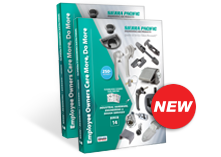Compression Latches
Our compression latches are available in a wide selection of finishes and materials, which ensures you can find the ideal configuration to align with your intended application.
More About This Section
SPEP Compression Latches
Choosing the right access hardware for your industrial project is key to streamlining the manufacturing process and maximizing asset performance. The industrial hardware you choose will also impact the end user’s experience and ultimately influence your brand’s reputation.
Therefore, it is vital to source your access hardware from a reputable manufacturer like Sierra Pacific Engineering and Products (SPEP). SPEP manufactures a broad range of critical access hardware components, including a variety of compression latches.
Our latches are available in a wide selection of finishes and materials, which ensures you can find the ideal configuration to align with your intended application.
What Are Compression Latches?
Compression latches are designed to hold panels, doors, or container access hatches shut. Unlike traditional latches, compression latches feature a gasket that seals the compartment against the elements. The seal created by a compression latch’s gasket also prevents rattling due to vibration or motion.
These latches are available in a wide range of depths, sizes, and configurations. There are several different types of gaskets available as well. The configuration, latch depth, and gasket style impact the latch’s performance and durability.
How Do Compression Latches Work?
Compression latches are a unique type of cam latch. When an operator closes a compression latch, the gaskets compress against the panel or door openings. This compressive force creates a tight seal, which keeps dirt, dust, and moisture out of the container and prevents or limits rattling.
When an operator triggers the latch mechanism, the locking arm then releases tension on the gasket, thereby breaking the seal. Depending on the configuration of the compression latch, the operator will need to release the locking arm by pressing a button or turning a key.
What Are the Types of Compression Latches?
There are many different ways to classify compression latches. However, the two largest categories of compression latches are locking and non-locking.
Non-Locking Compression Latches
As the name implies, non-locking compression latches have no locking mechanism. Instead, they are activated using a raised trigger. This is the simplest type of compression lever latch.
Lift-and-turn compression latches are another popular type of latch. These latches are available in both non-locking and locking configurations. When operating these latches, users must lift the latch and then rotate it to engage or disengage the gasket-sealing system.
Locking Compression Latches
The majority of locking compression latches use a key-based mechanism. Key-locking latches are a convenient means of securing exterior enclosures, such as those affixed to fire trucks or other emergency response vehicles.
Additionally, some compression latch systems feature padlocking capabilities. Attaching a padlock to a compression latch provides additional protection against theft or unauthorized access.
When choosing between locking and non-locking compression latches, consider the intended application. If the compartments will be used to store potentially valuable items, locking compression latches will usually be the better option.
Compression Latch Material Types
As a leading compression latch manufacturer, SPEP offers access hardware in a wide range of material and finish options. Our compression latches are available in:
Die-cast zinc
Steel
Stainless steel
304 SS
316 SS
The gaskets for our latches are typically manufactured out of rubber or a combination of rubber and plastic components.
SPEP proudly offers compression latches in a broad array of finishes as well, including:
Black powder-coated
Matte black powder-coated
Chrome-plated
Zinc-plated
Textured and chrome-plated
Passivated
Gray
Electropolished
Copper-plated
Nickel-plated
When selecting a material and finish combination, consider the intended application for your latches. For instance, hardware that will be installed on outdoor equipment should incorporate a corrosion-resistant material and finish to maximize longevity.
What Are the Benefits of Compression Latches?
Compression latches are an extremely popular access hardware solution due to the many benefits they provide. Specifically, compression latches:
Are extremely user-friendly during installation and operation
Seal out water and dust
Eliminate noise and vibration
Provide added security when equipped with locking mechanisms
Are available in multiple handle and actuator options
Are adjustable
As one of the most versatile types of access hardware, compression latches can meet the needs of a wide array of applications. They are commonly used in HVAC, electrical enclosures, emergency response, public transportation, motorsports, and many other industries.
Need Help Selecting a Compression Latch? Contact SPEP.
Sierra Pacific Engineering and Products supports the compression latch needs of a multitude of industries. While NEMA and IP qualifications vary greatly from latch to latch, we offer latches that meet the most stringent NEMA and IP standards, as well as more cost-effective options that are a good fit for general-use applications.
If you would like to learn more about our selection of compression latches or need assistance choosing the best hardware for your project, we invite you to contact SPEP today.

